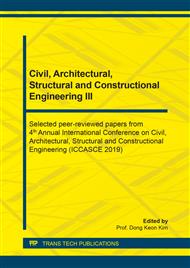p.195
p.202
p.211
p.221
p.226
p.231
p.239
p.245
p.250
Evaluation of Building Structure Resilience due to Flood Disaster that are outside the Riverbanks in the Floodplains
Abstract:
. Landuse changing along the Bidara Cina, downstream of the Ciliwung floodplain deteriorates its environmental quality. Its interactions between the building along the floodplain and the river dynamics can be simulated with Ansys Fluent as a simulation tool. This tool simulates the impact of floods could damage the buildings structure that built in flood zones but are still within the limits of habitable zone permits. Ansys Fluent modelling is using CFD parameters, by creating geometric scenarios that have been physically tested. The geometric behavior observed through the effect of large window openings (Experiment x), namely model 1 with one window and model 2 with 2 windows, then it is analysed by rotating 0°, 30°, 45°, 60° and 90° of the building (Experiment y). The outputs that will be analyse from flood induced the building are (i) flood impact force, (ii) total force of building, and (iii) reduction of flow velocity in building. From the simulation result, it is found that building geometry with larger openings is better at resisting the impact strength of floods and reducing the velocity of flood flows. Furthermore, the graph of flood impact force and the total force of orientation in model 1 and model 2 have a tedency to increase while rotation angle increasing. We conclude that based on building type (Experiment x), the model with one window is most vulnerable model and based on building orientation (Experiment y), the model with orientation 90° is the most vulnerable model, but when viewed based on facade that is exposed to the main stream there is an opening, the orientation of 60° is the most vulnerable model.
Info:
Periodical:
Pages:
239-244
Citation:
Online since:
April 2020
Authors:
Keywords:
Price:
Сopyright:
© 2020 Trans Tech Publications Ltd. All Rights Reserved
Share:
Citation:


